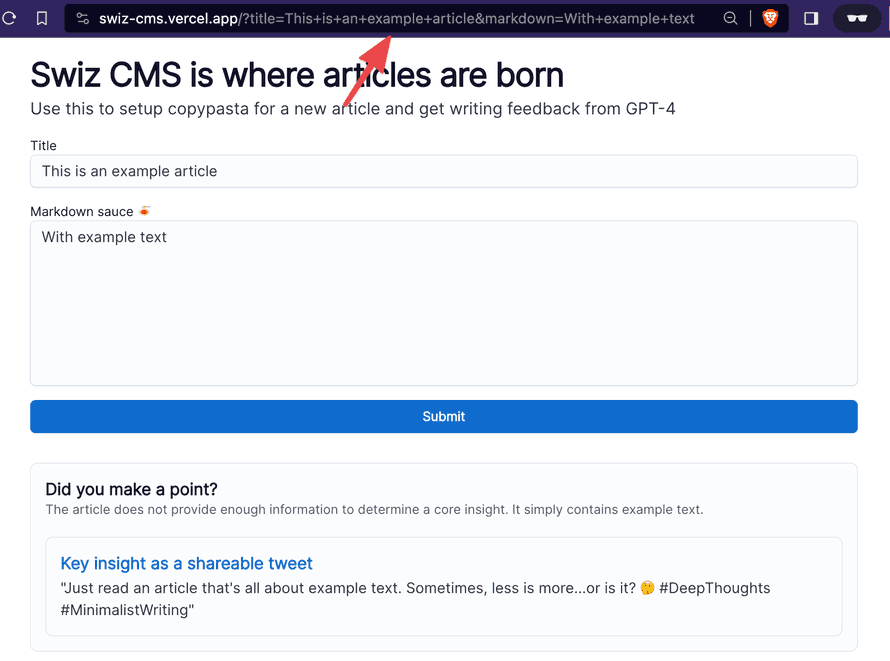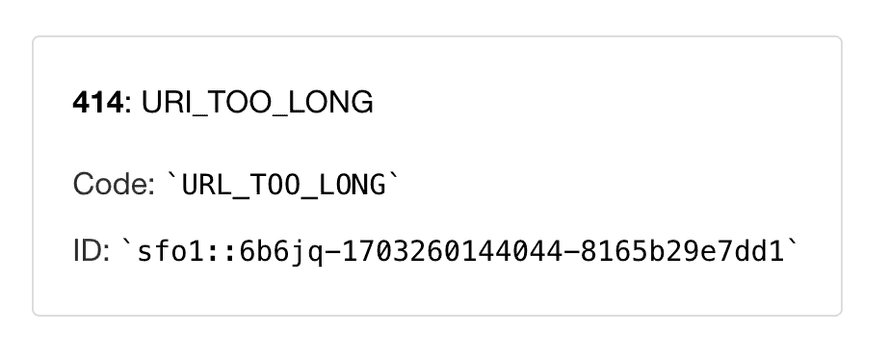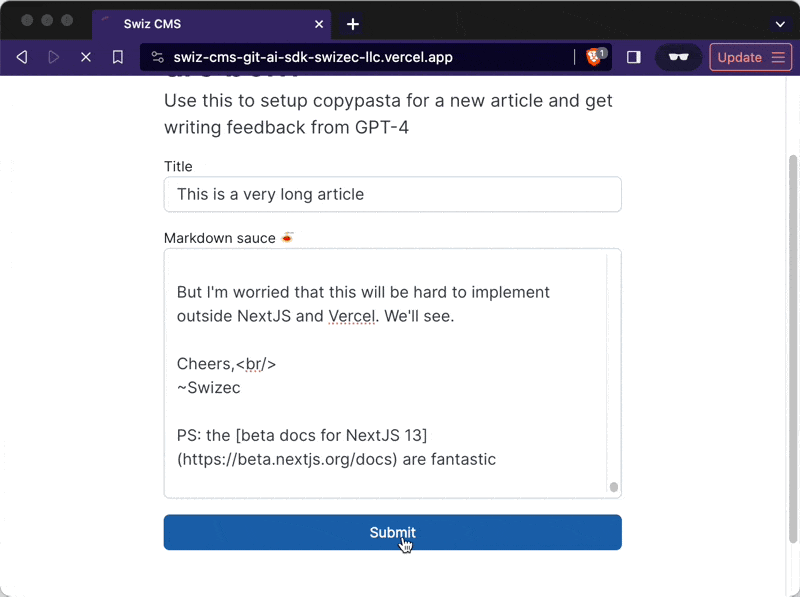Did you know Vercel limits URLs to 14kb? I know because I'm awful 😂
For the past few weeks I've been updating my Swiz CMS as an excuse to explore NextJS 14, the app router, and React Server Components. My goal was to avoid client-side API calls.
Implicit API calls with server components
Okay you got me, you can't avoid API calls, but the new async react tech lets you make them implicit and let the framework handle all details. Wrap a component in Suspense and it becomes an API call.
<Suspense fallback={<Loading title="Did you make a point?" />}>
<KeyInsight title={title} markdown={markdown} />
</Suspense>
That suspense boundary renders the fallback component while it waits for its children to resolve. The framework makes an API call to a serverless function that renders the Improvements component on the server and returns the HTML. It then injects that HTML into your page.
Improvements handles all data loading right there in component body. Makes your code pretty neat.
const Improvements: FC<{ title: string; markdown: string }> = async ({
title,
markdown,
}) => {
const feedback = await askForFeedback(title, markdown);
const stream = OpenAIStream(feedback);
return (
<Card>
<CardContent>
Notice the component returns a promise that resolves with JSX. That's how NextJS and React know to jump in and turn your code into implicit API calls.
Pages are server components also
Now, your page, the part of an app that renders when you hit a URL, is also a server component. The client-side makes an implicit API call to a serverless function, server renders an async React component, and returns the HTML. Framework injects this into the page.
All good.
But how do you handle forms? 🤔
You can't POST to a page. Pages are GET and super cacheable. They're not supposed to handle data mutations.
And because your page is a server component, you can't make it interactive. Typical form code that you're used to will throw an error:
<form onSubmit={doAthing}>

You're meant to use React's new form actions. They let you run a function as an implicit API and do things on the server.
For that to work in Swiz CMS, I'd need a storage solution. Form action saves data, redirects to new page, page shows results.
But I don't want a storage solution. That makes the project too complicated. I fill Swiz CMS with garbage all the time, I don't want every input stored forever.
Abusing GET params
Here's what we can do – abuse GET params 😈
Put form inputs in the URL, reload back to the same page, render additional fragments below the form. Like this:

Every fragment can use parallel routes and behave like a mini page. Make API calls on the server, process data, render JSX. Router handles implicit Suspense boundaries, server communication, and injecting the HTML into parent page.
You read the input straight from searchParams. No storage required.
export default function Feedback({ searchParams }) {
let { title, markdown } = searchParams as {
title?: string;
markdown?: string;
};
// ...
<Suspense fallback={<Loading title="Did you make a point?" />}>
<KeyInsight title={title} markdown={markdown} />
</Suspense>
Perfection 👌
But there's a size limit
Back in the day a URL couldn't be longer than 4096 characters. Memory was scarce, storage for logs expensive, and you wouldn't want to overwhelm a poor underpowered router between you and the server.
Nowadays an IKEA lamp has enough compute to run DOOM. Because that's cheaper than a custom on/off controller.
We can afford longer URLs and my awful code works great on localhost. On Vercel though ... it also works. Until you paste a looooong article.

This only happens when using the edge runtime. I need the edge runtime because OpenAI calls with long inputs are slow and the serverless runtime times out after 15s. There's no limit on edge. 🤷
The solution? Compress inputs!
Here's where it gets awful. You can compress inputs before feeding them into GET params. Then decompress on the server before use.
Yes it's awful. Yes it works.

Obviously performance is slow and that's a big part of why I'm a bad person for doing this. But it works! 🥳
Thanks to TkDodo for recommending the LZString library. Gzip didn't work, but LZString has a special compressToEncodedURIComponent function that packs your input into a URL-compatible format.
Here's the code. I did have to make the form a client component because React's form actions freaked out trying to do this compression on the server.
export const ArticleForm: FC<{ title?: string; markdown?: string }> = ({
title,
markdown,
}) => {
function onSubmit(event) {
event.preventDefault();
const title = event.target.querySelector("[name=title]").value;
const markdown = LZString.compressToEncodedURIComponent(
event.target.querySelector("[name=markdown]").value
);
window.location.href = `?title=${title}&markdown=${markdown}`;
}
return (
<form method="get" onSubmit={onSubmit}>
Why this is awful
The URL in that final example comes out to 8408 characters. Do you want to deal with that in your logs? 😂
~Swizec
Continue reading about People like me are why you shouldn't run a hosting company
Semantically similar articles hand-picked by GPT-4
- Why serverless fits side-projects perfectly
- Your first NextJS app – CodeWithSwiz
- Why NextJS /api routes are fab – CodeWithSwiz 6
- Exploring NextJS with a headless CMS, pt4 – CodeWithSwiz
- Async React with NextJS 13
Learned something new?
Read more Software Engineering Lessons from Production
I write articles with real insight into the career and skills of a modern software engineer. "Raw and honest from the heart!" as one reader described them. Fueled by lessons learned over 20 years of building production code for side-projects, small businesses, and hyper growth startups. Both successful and not.
Subscribe below 👇
Software Engineering Lessons from Production
Join Swizec's Newsletter and get insightful emails 💌 on mindsets, tactics, and technical skills for your career. Real lessons from building production software. No bullshit.
"Man, love your simple writing! Yours is the only newsletter I open and only blog that I give a fuck to read & scroll till the end. And wow always take away lessons with me. Inspiring! And very relatable. 👌"
Have a burning question that you think I can answer? Hit me up on twitter and I'll do my best.
Who am I and who do I help? I'm Swizec Teller and I turn coders into engineers with "Raw and honest from the heart!" writing. No bullshit. Real insights into the career and skills of a modern software engineer.
Want to become a true senior engineer? Take ownership, have autonomy, and be a force multiplier on your team. The Senior Engineer Mindset ebook can help 👉 swizec.com/senior-mindset. These are the shifts in mindset that unlocked my career.
Curious about Serverless and the modern backend? Check out Serverless Handbook, for frontend engineers 👉 ServerlessHandbook.dev
Want to Stop copy pasting D3 examples and create data visualizations of your own? Learn how to build scalable dataviz React components your whole team can understand with React for Data Visualization
Want to get my best emails on JavaScript, React, Serverless, Fullstack Web, or Indie Hacking? Check out swizec.com/collections
Did someone amazing share this letter with you? Wonderful! You can sign up for my weekly letters for software engineers on their path to greatness, here: swizec.com/blog
Want to brush up on your modern JavaScript syntax? Check out my interactive cheatsheet: es6cheatsheet.com
By the way, just in case no one has told you it yet today: I love and appreciate you for who you are ❤️
